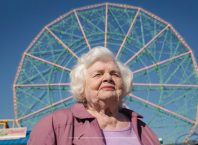By Shlomo Porath
I’m having a hard time reviewing Harry Potter and the Half Blood Prince (aka Harry Potter 6) on its own terms- I feel like I need to set up a context in which to talk about the film. So first I will provide an entirely subjective history of the film series to this point, and then get to the latest installment.
When the Harry Potter film series was launched in 2001, it seemed destined for mediocrity. Although tremendously successful, the first two films –The Sorcerer’s Stone (2001) and The Chamber of Secrets (2002) – were bland and unimaginative carbon copies of their books. Directed by Chris Columbus, these films were showcases for effects, sets and costumes, all of which felt synthetic and newly fabricated. The only authenticity to be found in those films was the work of the superb adult cast, which includes many of England’s finest and most respected thespians.
But then, something interesting happened.
Chris Columbus stepped down from the director’s chair, and the producers hired Alfonso Cuaron to direct the next film, The Prisoner of Azkaban (2004), including a wide latitude with which he could redesign the world. Although Cuaron had under his belt solid Hollywood films like A Little Princess and Great Expectations, it was an admirable move to give him the room he needed to reinvent the world, in view of how much money the first films made. Cuaron’s previous film was 2001’s Y Tu Mama Tambien, about two horny young men on a road trip with an older woman they have a crush on. That may sound like a sex-comedy, but, in fact, it is about friendship, sexuality, and really is a meditation on facing one’s mortality. Not exactly the kind of themes that the Potter series was known for (Only 4 of the books had been released at that point).
Cuaron hardly turned his film into a heavy and meditative drama, but his sensibility transformed the cinematic world of Potter. Gone was the whimsy of the first two films, with the constant pyrotechnics that screamed “MAGIC!!!” as often as possible, and that is replaced by an elegant mischievousness, and with small flourishes at the edges of the screen that kept the magical element alive. Also, no longer was this a fanciful tale of lucky kids on another plane of existence. By stripping away the fantastical, these adolescent protagonists became real and relatable teens. They looked and sounded like actual 13 years olds, and existed in a world that, although magical, seemed believable, lived in, and practical. Paradoxically, the third film was all the more magical for focusing on the mundane, for making this world seem like it is right next door to ours.
The precedent Cuaron set is critical in understanding the direction of the series. The fact that the films have a huge built-in audience doesn’t hurt, but such an interesting choice of director is a rare occurrence with films of this size and budget. Although it made less money than its predecessors (in fact, it is the lowest grossing Potter film to date), artistically speaking, the gamble it paid off in spades, and Harry Potter and Prisoner of Azkaban is one of the very best examples of pop-filmmaking in recent years.
For The Goblet of Fire (2005), the fourth entry, the producers went to Mike Newell, an established director with a checkered past- Four Wedding and a Funeral and Donnie Brasco, but also Mona Lisa Smile and An Awfully Big Adventure. His Potter, unfortunately, falls into the latter set of failures. Most directors would have trouble rising to the challenge posed by Cuaron’s success, but Newell’s film is almost as unimaginative as Columbus’s duo, and the book Newell adapted provided far better material than what Columbus was working with. I found it to be a tedious film, and was quite disappointed that the fourth film did not continue the trend of the third one.
Luckily, the producers went with an audacious choice for the next director. They hired David Yates, a director entirely unknown outside of the UK, and in the UK known for his extensive work on television. Yates had certainly never made a film of this size before. But once again, the surprising choice paid off. Although it at times feels rushed (which makes sense, as it is an adaptation of the longest book in the series), The Order of the Phoenix (2007) is an engrossing, briskly paced thriller that does a good job of capturing Harry’s inner conflict, but felt light on its feet and in general recaptured the balance between magical wonder and teen reality that Cuaron introduced.
The forces-that-be were so impressed with Yates’ work that they brought him back to translate to the screen the last two books in the series (The seventh book was split into two films, to be released in fall 2010 and summer 2011, respectively).
Now, after that long preamble, I’ll get to the matter at hand- Harry Potter and the Half Blood Prince.
* * * * * *
Like the film, this review I’m sure will seem somewhat unfocused and oddly paced; I can’t tie my thoughts together for a conclusion like the film does (which does hit most of the right notes and contains some great images), but I hope to get in enough to make it worth your while.
For some strange reason, I found that the newest film in the series raised in me more questions about the adaptation from book to film than any of the previous ones. I was disappointed by the first two films’ slavish devotion to Rowling’s writing, and was thrilled by the third film’s faithfulness to the spirit of the writing, while being a uniquely cinematic achievement. With the next two, I was more preoccupied with the loss and subsequent re-capture of that cinematic vision than with their relationship to the source material. This film felt denser than the others, and felt like it altered more of the events of the book than the others. I say ‘felt like’ because the book’s plot was not fresh in my mind- I had to skim it after seeing the film to get a sense of the changes.
Those changes are evident from the very first sequence. Yates and screenwriter Steven Kloves (who wrote all the films except for the fifth) condense the implications of the relatively subdued opening of the book into one sensational montage of the Death Eaters (for the uninitiated- bad guys, servants of Lord Voldermort, the head bad guy) wreaking havoc on the muggle (non-magical) population of London. It’s a terrific sequence that plunges you right into the film. The pace slows down for a spell, with a reintroduction of the sinister Professor Snape, as well as the introduction of the story’s major new character, Professor Horace Slughorn. It’s hard to complain about the change of pace, though, as the professors are played by two of the most compulsively watchable British actors around- Alan Rickman and Jim Broadbent. Rickman is one of the consistent joys of the series. His part in the films are condensed to a few choice scenes, but his delivery is so brilliant that a sentence from him is all that’s needed to assert his presence (I don’t think I’ve ever seen someone more adept at stretching out syllables). Broadbent breathes a tremendous amount of life into his character, who didn’t leave much of an impression in the book. Slughorn is a vain celebrity-worshipper -a professor that “collects” famous students- but Broadbent makes him a poignant old fool and redeems the character beautifully.
In the lead, of course, we have Daniel Radcliffe as Harry, along with Rupert Grint and Emma Watson as his best friends Ron and Hermione. It might just be that I’ve grown accustomed to his face, but Radcliffe is pretty solid. He hits some wrong notes here and there, but he has a good handle on his character. Watson, attractive as she might be, often appears to be struggling in her role. Ever since the fourth film, she’s been huffy and unnatural. Grint, on the other hand, is probably the most talented of the three, and he carries his scenes with aplomb, even the belabored romantic ones, which are unfortunately presented bluntly and are some of the least involving scenes in the film.
I haven’t so far delved into the plot, and that’s because as dense as this film is, it seems to be almost impossible to maintain the consistent, driving, plot from the book, even at a generous 154 minutes. The only plot strand from the book that is really fleshed out is Slughorn, who has information that headmaster Dumbledore (Michael Gambon) needs. Dumbledore brings Harry along when he recruits Slughorn to come back to his teaching position at Hogwarts and gives Harry the task of allowing himself to be “collected” by Slughorn in aid of extracting the information. This information exists in the form of a memory that Slughorn has of a specific conversation with the young Dark Lord Voldermort, when he was still a student at Hogwarts.
Unfortunately peripheral in the movie is the plot-line involving the Half-Blood Prince of the title. The Half-Blood Prince is the name Harry finds on an old potions text-book, and this mysterious character has written all over this book. Sometimes it’s an improvement on the book’s instructions, sometimes it’s a homemade spell of potion, sometimes it’s just rambling thoughts. This makeshift and unique diary was a driving force in the book, and its effect has been significantly lessened in the film. When the true identity of the self-anointed Prince is finally revealed, it packs a rather weak punch.
On the plus side, the film makes excellent use of Harry’s nemesis (well, his other nemesis, after Lord Voldermort), the Aryan Draco Malfoy. Malfoy’s antagonism to all things good has been simmering since the first book/film, and finally boils over in this installment. Aside from a couple of scenes at the beginning and a big one at the end, Malfoy doesn’t have much screen time. But Tome Felton, the actor portraying him, took a note from Rickman’s book, and has such a focused intensity that he stole the movie (for me at least). Like Harry, Malfoy has also been put on a mission, but his struggle is made even more palpable throughout. Every once in a while, when the movie settles into an entertaining but unfocused pace, Felton appears on the sideline, and refocuses it. After a banal scene where Hermione huffs at Ron’s cavorting with another girl, the camera will tilt, pan, or track to a different part of the Hogwarts castle, where Malfoy is single-mindedly pursuing his sinister mission (In the film’s finale, it was Felton I was watching, even with Gambon as Dumbledore nailing the lines like he always does).
There is plenty more to talk about in terms of theme and story, but this piece is already longer than had anticipated, and I would like to mention one very welcome aspect of the production- the visual effects. It’s a handsome production throughout –Stuart Craig’s production design and Bruno Delbonnel’s cinematography are extremely rich- but I found the visual effect to be particularly impressive. Like Star Trek earlier this year, the effects here struck me as far more inventive and inspired than your typical extravaganza’s effects. Unlike Star Trek, though, the effects here are not always slick and polished. Some of it looks even quaint by today’s standard. Far from being a flaw, however, it added to the sense that these effects were imagination-based, not skill-based. Sure, we get the typically effective digital enhancements throughout (though my hunch is that this film has fewer CG images than the previous films), but in a few select scenes, the effects are a triumph of imagination, particularly the penultimate sequence.
The cave sequence was one of my least favorite chapters in any of the books –Pulp, when I was geared up for Epic…it felt like a Hardy Boys scene. But that was somewhat redeemed by the beauty of the fire created here. That fire looked so awe-inspiring that it nudged the scene closer to the epic, particularly the image of the fire-balls, launched under water. Also beautifully realized is the effect of a liquid memory (held in a vial, looks like mercury) being poured into a basin of water, solidifying into the shapes of the buildings, objects and people that the memory contains. Lastly, I will mention the final images of the finale, which alter the book significantly, but sum it up in a visual concept I found stunning.
As I stated- I found this a curious but interesting film to talk about. Its successes are easy to find on a micro level, but somewhat harder to explain as a whole. It’s similar with its failings- easy to pinpoint on a scene-by-scene basis, but difficult to explain as whole. It is somewhat bold in its narrative structure, but that is boldness-by-necessity, trying to condense 600+ pages into 154 minutes. It’s one-damn-thing-after-another, yet my interest rarely waned. Still, this compromise hinders the film, and the series as a whole, from ever really standing on its own two feet, apart from its source material, like The Lord of the Rings movies do (or at least come pretty damn close). Nevertheless, I find the progression of the film series fascinating, even if I’ve only liked half of the movies to date. After the success of this film -curious and relative as it is- I am eagerly anticipating the final two chapters, more so than any of the previous films. For me, at least, Alfonso Cuaron and David Yates have managed to turn a stillborn film-series into a fascinating and evolving cinematic event.
P.S. Although I only briefly mentioned the other crucial contributors, there are obviously many people responsible for these films. However, the only constant in the most interesting elements of the series have been the directors.





